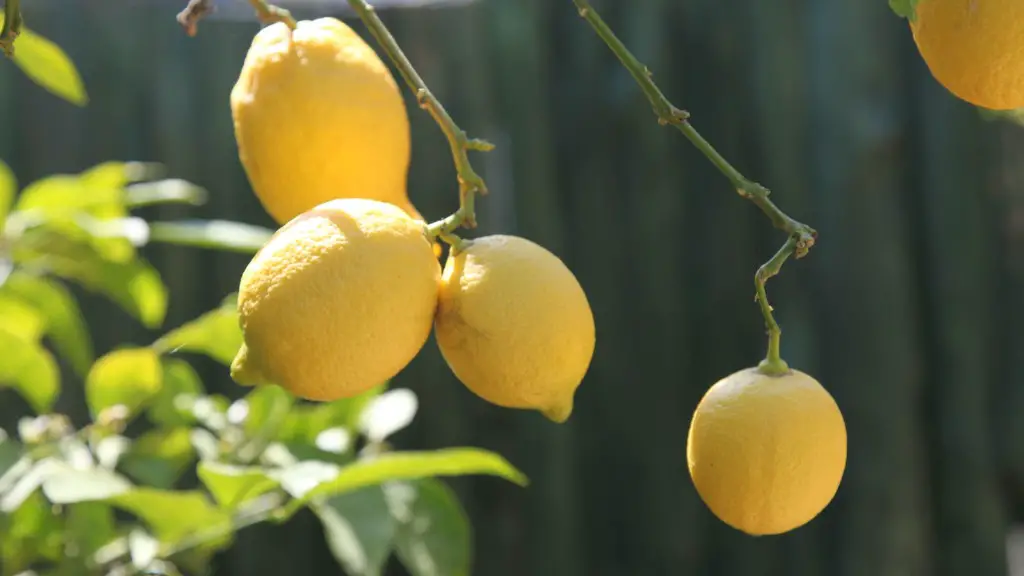Despite the challenges posed by having a lemon tree indoors, many dedicated gardeners are willing to take up the challenge. With adequate lighting, proper soil, and regular watering, a lemon tree can thrive indoors for many years. Growing a lemon tree indoors takes a lot of work and patience, as the tree will need to be repotted and pruned periodically. To ensure success, it is important to select a lemon variety that is able to flourish in an indoor setting and to maintain consistent levels of humidity, temperature, and sunlight.
Choosing a variety that’s well-suited for indoor growing is essential. Meyer lemons are a popular choice, as they are known to do well in containers and have a sweeter taste than other lemon varieties. Other varieties such as Eureka and Lisbon may also thrive indoors, given the proper care. Smaller lemons such as Bearss limes also fare well indoors as they’re typically more disease-resistant than larger lemons.
Once you’ve chosen a suitable variety, you’ll need to carefully assess the position of the tree, making sure the tree will receive bright but indirect sunlight, as too much direct sunlight can damage the leaves. You’ll also need to provide adequate drainage for the tree, as soggy soil will quickly kill a lemon tree. To ensure proper drainage, make sure the pot has multiple draining holes – preferably, one draining hole at the center of the pot and four to five small drainage holes around the outside.
When it comes to soil, it’s essential to find a potting mix that’s aerated, nutrient-rich, and well-draining. Vermiculite or perlite are good additives, as they help loosen the soil and aid drainage. The soil should be kept slightly moist at all times, as too much water can cause root rot and limit oxygen uptake, and too little water can lead to wilting. A good rule of thumb is to water the tree once a week, checking the soil for moisture with your finger before deciding how much water it needs.
Finally, you’ll need to provide adequate humidity for the tree. If the air in your house is too dry, you can use a humidifier or set up a shallow dish with stones and water to increase the humidity around the tree. This will also help prevent spider mites, a common indoor pest, from infesting your lemon tree.
Caring for a Lemon Tree
Unlike outdoor lemon trees, indoor lemon trees require frequent repotting and pruning to maintain a manageable size and ensure a good crop of fruit. Be sure to repot the tree every two to three years, using a potting mix specially formulated for citrus trees.
Pruning is also necessary to maintain an optimal size and for the health of the tree. When pruning, start by removing any dead branches, as well as any branches that are growing too close together. Aim for an “open” center, which will allow for good airflow throughout the tree. Prune the sides of the tree to the desired shape, usually rounded or slightly conical. Don’t be afraid to prune hard – it won’t hurt the tree, as long as you leave the center open.
Regular fertilization is also necessary to ensure the tree remains healthy and productive. Feed the tree regularly with a citrus fertilizer, but make sure to dilute it, as too much fertilizer can burn the roots. Also, if the tree begins producing too much fruit, pick some off as it can cause stress for the tree.
Finally, watch for signs of pests or diseases. These can include discolored or mottled leaves, spots on the fruit, and other signs of distress. If you suspect your lemon tree is infected, it’s best to err on the side of caution and remove the affected branches or fruit. Make sure to avoid pesticides, as they can further damage the tree.
Harvesting Your Lemon Tree’s Fruits
Once your lemon tree begins to produce fruit, you can begin harvesting the lemons when they are bright yellow and plump. To pick the lemons, simply snap them gently off the branch. Don’t wait too long to pick them, as lemons tend to turn more yellow and less acidic after they’re picked.
Harvested lemons can be stored at room temperature for a few weeks or in the refrigerator for up to two months. To keep them at their freshest, make sure to store them in paper bags or breathable bags like muslin. If the lemons are left on the tree too long, they will become overripe and may not be very tasty. Keep an eye on the lemons and pick them when they’re ripe.
Yearly Maintenance for Lemon Trees
Once your lemon tree has matured, you’ll likely need to perform some yearly maintenance to keep it healthy and productive. To ensure the Soil is still fresh, you should replace the top layer of the potting soil each year. This can be done by completely removing the top layer of soil and replacing it with a fresh potting mix.
Pruning is also a necessary maintenance task. Prune the tree early in the season, while the tree is still relatively dormant. Make sure to remove any dead branches and trim back the sides of the tree to maintain a rounded or conical shape. Once the tree has finished producing fruit, it’s a good idea to prune back some of the branches to force it to produce more fruit the following season.
Finally, it’s important to fertilize the lemon tree each year. Fertilize the tree with a citrus fertilizer, diluted to half-strength, once every four months. This will provide the tree with necessary nutrients and will help it remain healthy and productive.
Pests and Diseases
Like with any plant, pests and diseases can be a major threat to a lemon tree’s health. The most common pests and diseases include fungal infections, scale insects, and spider mites. To prevent these, make sure to keep the tree away from windows and other sources of direct sunlight and to inspect the tree regularly for signs of pests or diseases.
If pests are found, it’s best to remove them gently with a cotton swab dipped in alcohol, as this will kill the bugs without damaging the tree. If you are dealing with a fungal infection, you can apply a fungicide to the affected area. It’s also important to make sure the tree is receiving adequate airflow and oxygen or the disease can spread quickly.
Scale insects can be a particular challenge for lemon trees. These insects can quickly infest the fruit, ruining it in a matter of days. To get rid of these pests, you can use a pesticide or you can handpick the insects off the tree. The key is to catch the problem as early as possible and to remove all traces of the bugs, as they can reproduce quickly.
Finally, regular dusting is also important for keeping pests away. Dust the leaves of the tree every two weeks to keep the foliage free of bugs and dirt. This will also help the tree to receive more sunlight and provide it with adequate levels of humidity.




